Did you know the Arctic Tern flies more than 40,000 km. from southern Chile to the Arctic and back every year? It is one of more than 250 species of migratory birds that uses Lesser Slave Lake as a major resting point – often compared to Point Pelee (Southern Ontario) in terms of migratory importance.
A group of birds playing by the shore – the Arctic Terns are the ones with black heads.
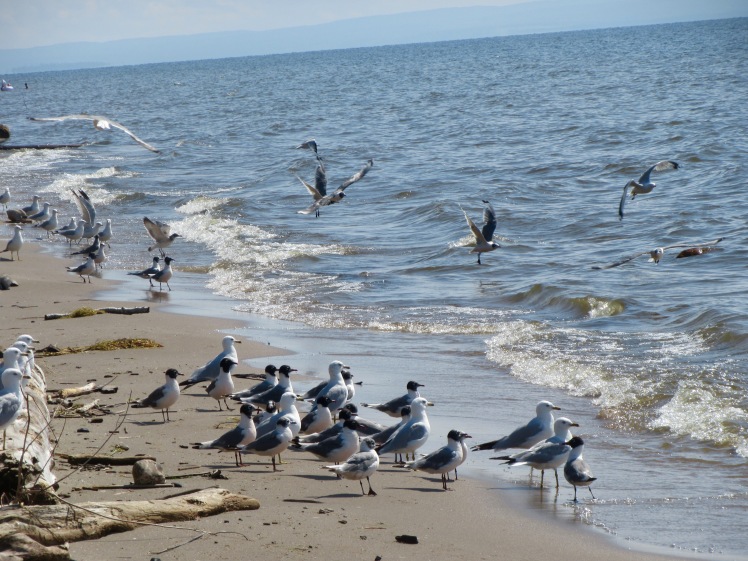
This is just one of the fascinating facts we learned while visiting Lesser Slave Lake Provincial Park, about four hours north of Edmonton. The Boreal Centre for Bird Conservation is one of the attractions in the park and we dropped by to learn more about what birds might be in the area. It houses an excellent interpretive area.
The centre is a world-class research and education facility and a site for visiting students and researchers.

Unfortunately we were in the area just between seasons for many of the major migratory birds and about three hours too late in the morning to wander the nearby Songbird Trail to any great effect. We didn’t miss out entirely though – we woke up every morning in our campsite about 6:00 am to cacophonous birdsong.
We were primarily at Lesser Slave Lake for the pristine camping and swimming but serious birders should not miss this spot.
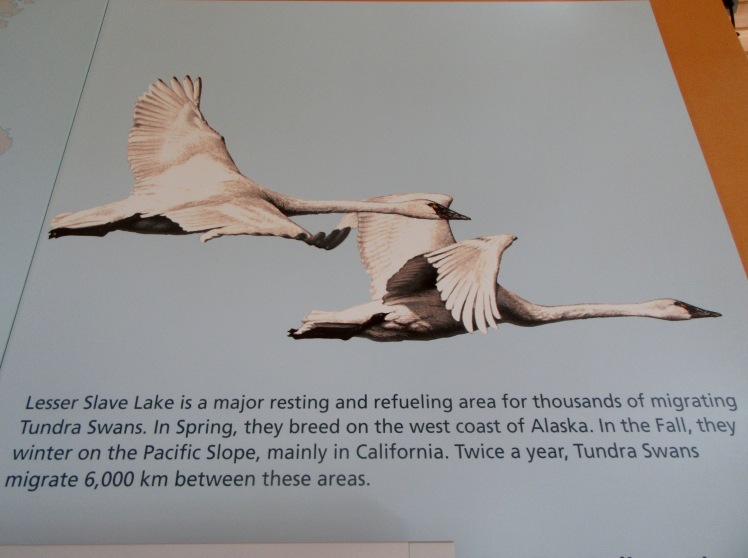
Our camping at Lesser Slave Lake was a full-on Discovery Channel experience. The first night there we woke up to an explosive thunderstorm. It had been brewing for a couple of hours – threatening skies and distant rumbles, but when we tucked into our tent for the night, there was not as much as a raindrop.
A couple of hours later – boom – thunder and lightening right overhead, crackling and pounding. Water pummelled our tent as though a giant was hurling buckets at us. It was thrilling but a bit unnerving and a bit disappointing – we wanted to watch this fantastic show, but felt pinned to the spot. We were so warm, dry and cozy and not willing to zip and unzip the tent and run to the car, getting soaked in the process.
The next morning, we woke to sunshine. Lesser Slave Lake is the second largest lake in Alberta – 100 km. long and 15 km. wide. From our perch on the white sand beach, it felt like we were staring straight out to sea. The water is delicious – you could almost drink it. Clean and cool with a sandy bottom – exquisite swimming. We are used to the buoyancy and life of ocean swimming, but I could be a convert to clean northern lakes. It was also quiet – home to kayakers, fishers, stand-up paddlers and a flotilla of inflatable rafts, sharks, and flamingos – not a jet-ski in sight. This is our kind of beach.

It is also home to amazing fishing; all the northern greats – walleye, pike, whitefish, perch and ling cod. We watched one man bring in a fish about 18″ long that his wife carefully measured before he headed off to the fish cleaning station. He caught that in about 15 minutes, just wading out to his waist from shore.
Hiking is another attraction. We headed for the nearby Marten Mountain lookout and again, we were dealing with threatening skies. We were just between systems, so weather remained changeable.

The fire station is at the summit. This tower serves as a lookout for signs of small fires that can be dealt with before they become a serious problem.

The fire of 2011 in Slave Lake was a catastrophe that covered 4700 hectares, destroyed 400 structures and resulted in $700 million dollars worth of damage. It was determined that it was likely the work of an arsonist. The town of Slave Lake has rebuilt, but the effects on part of the landscape will be evident for years to come.

We followed this path for about half an hour, but between our (my) worries about confronting a grizzly (heightened by the many warning signs), we lost our nerve and turned back. Time to buy bear spray and feel better equipped to enjoy the wilderness.
We followed fresh moose tracks for about a kilometre – I wish we could have seen him (her) from a safe distance.

We very reluctantly left Lesser Slave Lake a day early, as it was forecasting extreme thunderstorms. It gave us another taste of the north that we are keen to return to – next time with our trailer.
From Lesser Slave Lake, we headed south to Dry Island Buffalo Jump Provincial Park; a place recommended to us by our friend Laurence. The campgrounds right in the park were solidly booked for the long weekend, so we felt lucky to grab the last spot in a private campground about 20 km. away.
Our camping experiences so far have been wonderful, but they have all been in provincial parks, they are well monitored and contain what we regard as camping essentials – nicely treed private sites, evening campfires and quiet, respectful fellow campers. Our very own nature cocoons.
When we drove into the private campground near Dry Island Buffalo Jump my heart sank. A line-up of camping chairs stretched down the road for about three campsites, filled with adults with drinks in hand. A boisterous game of beanbag toss was in progress. Thwap. Thwap. Thwap – this sound, accompanied by screams and encouraging yells went on for hours. Music blasted from one of the RV speakers. A table was set up with an eye-watering amount of booze. We backed into our site, and began setting up our tent; knowing there were no other options at this late hour.
We also knew it would get much worse, but we figured they would be shut down by 11:00 pm (the enforced quiet time according to the sign.) The park was beautiful, set right on the Red Deer River, so we tried to concentrate on the positive, but we couldn’t help but feel envious of the other campers who were situated in quieter areas of the campground.

To make matters worse, another multi-family party set up right behind us and they carried on long into the night. We enjoyed our days away sightseeing, but our evenings were miserable, and our polite requests to keep the music down were ignored. Our complaint to the park operator fell on deaf ears, since “we can’t ask people to go to bed at 11:00.”
These were not bad people; inconsiderate certainly, but just different people looking for different things. We just had the poor luck of landing in a well-known party campground on a long weekend.
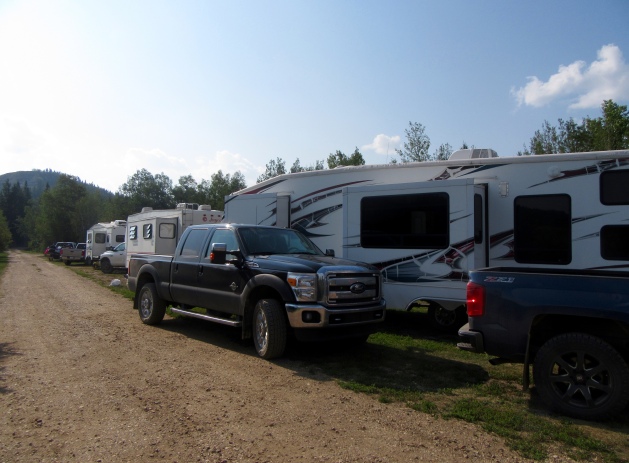
We made up for our disappointing experience in the campground by visiting the surrounding sites, primarily Dry Island Buffalo Jump Provincial Park. This is a little-known treasure of a park – very similar in terrain to the Badlands, with hoodoos and coulees, and scrub grasslands to wander for miles. This is also a prime fishing and rafting site.

We hiked in for about an hour, and then back again, hoping to spot a rattlesnake. We never did see one, but this little fellow visited us when we stopped for a picnic.

The area around Dry Island Buffalo Jump Provincial Park is beautiful. I’m guessing this countryside would be referred to as High Plains as it is rolling and lush with vast prosperous wheat and grain farms. And of course, this is the land of the famous Alberta beef. The calf was on the other side of the road when we drove by, but she scurried back over to mum for protection as we approached.

A nearby diversion was Big Valley (pop. 349), and home to the Big Valley Creation Science Museum. It was closed (in spite of the OPEN sign in the window), but plaques around the front lawn left little doubt that evolution was seriously being called into question.

Just around the corner was recreation of an old wild west town – the Jimmy Jock Boardwalk. Not much going on there besides a fudge shop and a restaurant.
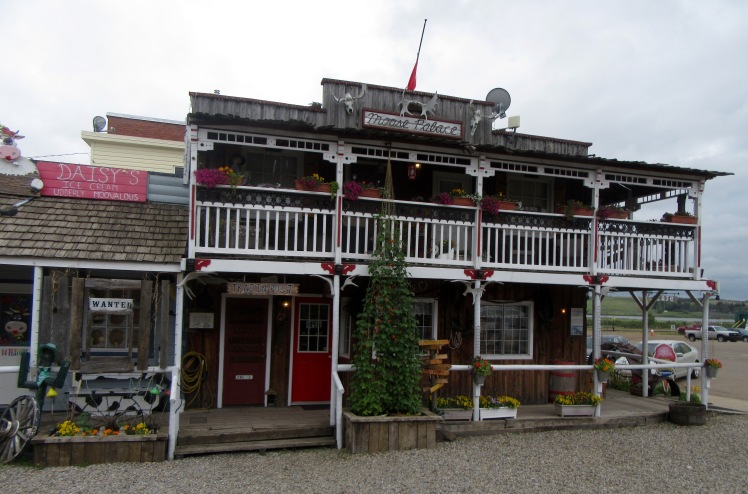
The original jail was just up the street; big enough for one drunken miscreant to cool his heels for the night.
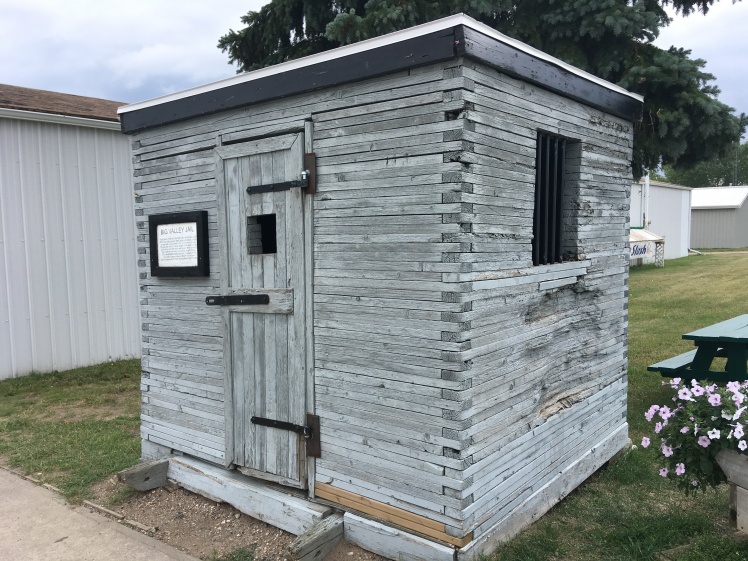
At the crest of the hill, the St. Edmunds Anglican Church (circa 1916) held a command post.
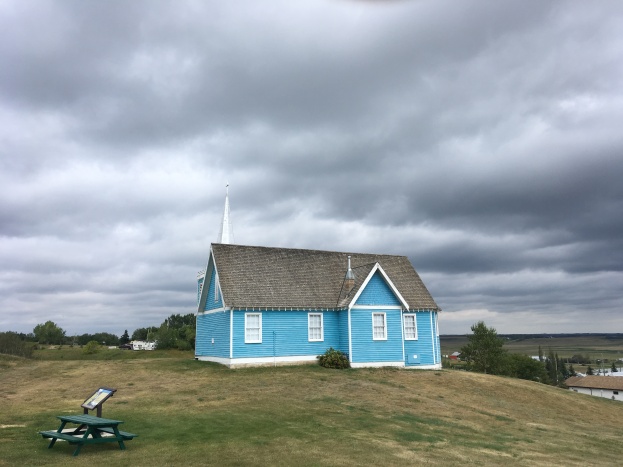
These small towns and hamlets rely on tourism to help prevent them from dying out entirely, and one enterprise here is courtesy of the Alberta Prairie Railway Excursions. They run old steam or diesel trains between Stettler and Big Valley, and package tours include the round-trip travel, on-board entertainment, plus a staged hold-up by armed and masked bandits – for the not-inconsiderable sum of $145. Once safely in Big Valley, dinner is served and then passengers return to Stettler – a six hour excursion in total. The trains appear to be packed every time.
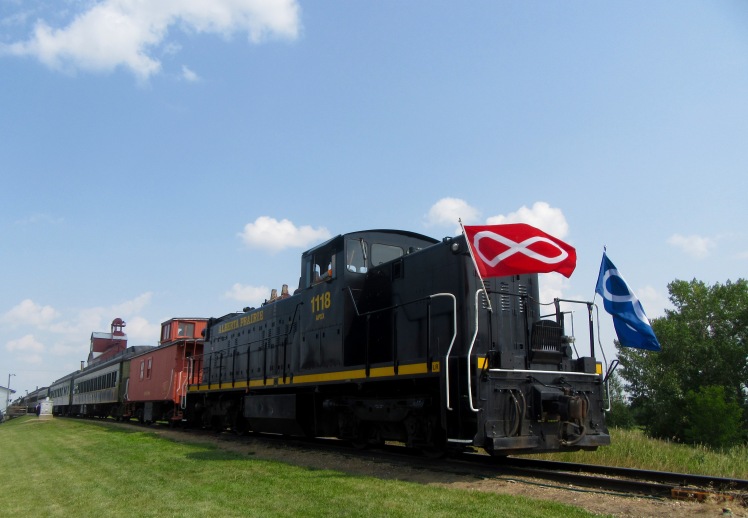
We stopped at DNA Gardens for a visit. This enterprising business sells, among other things, homemade kombucha, fermented vegetables and bat houses. We bought French vanilla ice cream from this self-possessed young woman – another face of Alberta.
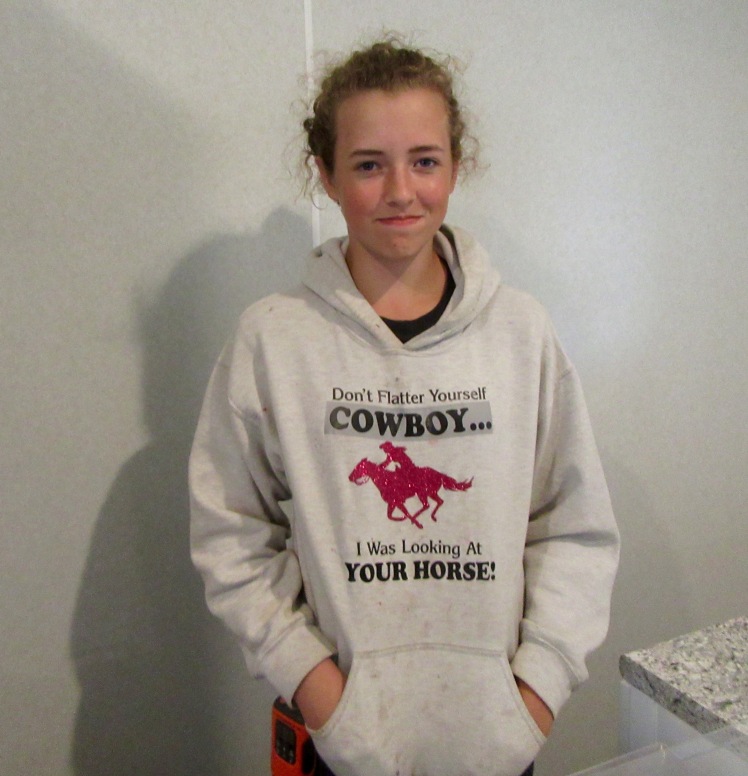
And finally…the town of Vulcan. This town can lay claim to the name long before Star Trek hit the screen – it was named by a CPR surveyor after the Roman God of Fire.

However, it has capitalized on the Star Trek series by building a themed tourist station, and sure enough – build it, and they will come. Overpriced merch and a chance to dress up as Spock – this was not reason enough to leave the highway, but a fun respite on our way to Fort MacLeod.
Learning a lot through your posts. Keep them coming, u two. Watch out for bears. Lol. You could have come here if that’s all you wanted.
LikeLike
but you don’t have grizzlies…
LikeLike
I have very fond memories of Lesser Slave Lake. It was where I caught my first (and only) fish ever! It wouldn’t have won any derby, that’s for sure, but as far as I was concerned, it was pretty special! It remember it being very peaceful out on the lake … thanks for bringing back the memories!
LikeLike
Heather, I’ve never gone fishing, but it looks like something I could get into, especially in these areas. Wade out into a creek, toss out a line and bingo…dinner.
LikeLike